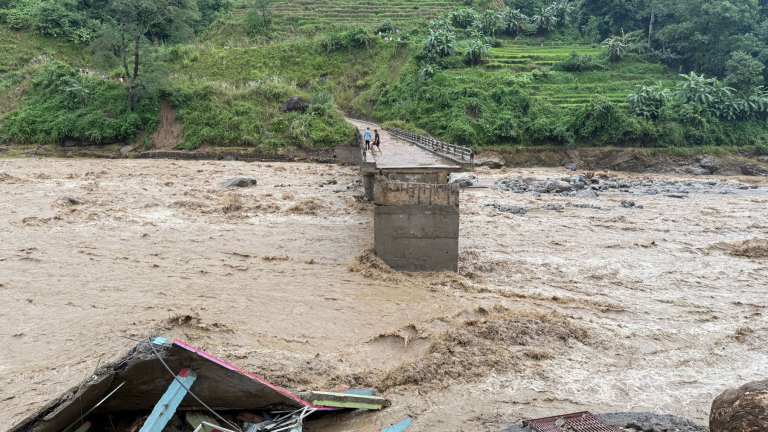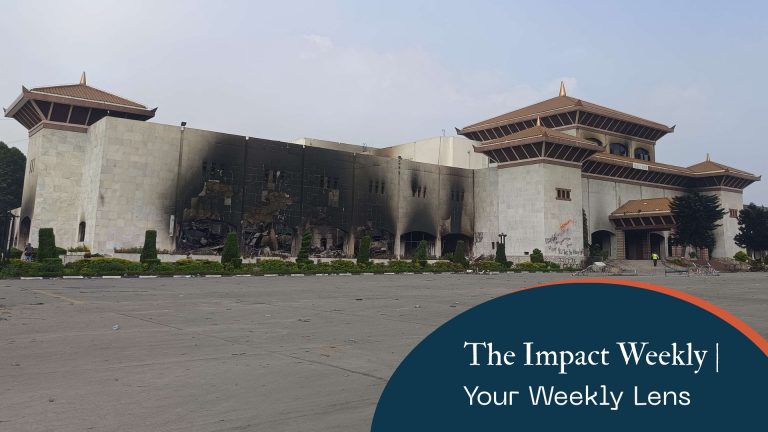Nepal is reeling from one of its most intense social upheavals in recent memory—the protests and violence on September 8 and 9. The unrest left 75 dead and damaged several public infrastructures and some large private investments in ruin. The economic toll of the unprecedented disruption is still being assessed, likely to be hundreds of billions.
In the aftermath of the crisis, a new interim government was swiftly formed, led by former Chief Justice Sushila Karki, becoming the first female Prime Minister of the country. The interim government is tasked with stabilising the nation and recovering from the crisis, and has set 21 March next year for the new House of Representatives election.
[Check out our previous issue to understand the scale of the damage]
Attention now turns to recovery plans and what measures will be prioritised, how reconstruction will be funded, and what action plan will guide the rebuilding of public services, businesses, and communities across the country.
Government initiatives: Post-protest recovery strategy
Compensation for lives lost
The interim government has declared all individuals who died during the protests “martyrs”, announcing a compensation of NRs 1.5 million per family.
Injured individuals will be provided free medical care, while families staying in Kathmandu will be provided with accommodation and food support.
Fund initiative for critical infrastructure and electoral support
Finance Minister Rameshwor Prasad Khanal announced plans to secure funds to rebuild damaged infrastructure and support the upcoming election. To fund these priorities, the ministry will be adopting a framework that will optimise government spending while reallocating funds from low-priority, fragmented, or politically driven projects that lack proper planning and feasibility.
Key guidelines outlined in this framework include:
Capital expenditure and project prioritisation
- Continue the operation of the approved projects to avoid disruption.
- Freeze funds for low-priority, unclear, or fragmented projects and projects without a clearly defined purpose.
- Redirect funds to national priority projects, ongoing initiatives with liabilities, and essential social sector programs like education, health, and clean drinking water.
- All reconstruction projects will be entered into the Line Ministry Budget Information System (LMBIS) for transparency.
- Funds may only be released if liabilities exist or a procurement agreement is signed or near completion.
- New projects in the current year will not receive multi-year funding until it is fully vetted.
- Contingency funds will be capped at 2% for projects under NRs one billion and 1% for larger projects to avoid excessive spending.
- The User Committees will not execute province-wise or local projects over NRs one million to prevent fragmentation and misuse of funds.
- Government structures under construction will be designed to be agile and functional.
Management of current expenditure
- New programs with unclear objectives will be put on hold.
- Non-essential meetings, workshops, training, and foreign travels will be restricted to save costs.
- Official allowances and facilities are reduced for effective spending.
- Office equipment, furniture, and vehicles will be reused whenever possible.
- Only hire staff when necessary, use temporary experts for specialised work, and avoid creating duplicate positions.
- Ministries are instructed to simplify organisational structure to reduce redundancy
Austerity and efficiency measures
- Monitor and minimise the utility cost (water, electricity, and communication)
- Insure government property and vehicles
- Avoid renting government offices and residences that exceed the functional needs.
- Restrict luxury and non-essential purchases.
Investment and resource management
- Government funds will only be mobilised in profitable, aid-backed, or nationally important projects.
- Institutions unable to generate returns or repay obligations are prohibited from issuing shares or raising funds.
- Ministries are responsible for recovering outstanding dues and ensuring funds are deposited into government accounts.
- Officials are limited to one vehicle, and replacements should come from existing fleets.
Arrears recovery and accountability
- Ministries must actively recover revenue and non-revenue arrears.
- All collected amounts must be deposited into government funds
- Heads of ministries and concerned bodies must regularly oversee and ensure compliance with the framework.
The Finance Minister Khanal estimates that up to NRs 100 billion could be made available through fund reallocation and cost-saving measures. In this pursuit, the Ministry has established a three-member task force—comprising divisional heads of budget and program, foreign aid coordination, and revenue management to assess and evaluate the existing budget allocation.
Meanwhile, Energy and Physical Infrastructure Minister Kulman Ghising has launched a campaign, namely “Let’s build our infrastructure together,” calling for public participation in funding to restore damaged infrastructure.
Recognising the limits of government resources, the MoF has additionally established the ‘Physical Infrastructure Reconstruction Fund’, which is designed to strategically pool the resources from the state, Nepali households, and diaspora to finance the repair and rebuilding of the damaged public and private infrastructure.
Similarly, the Ministry of Industry, Commerce, and Supplies has prepared a list of reform-oriented action plans aimed at encouraging private investment. This includes drafting a new Company Bill, reforming company administration, simplifying company registration and closure, introducing guidelines for equity shares, facilitating all foreign investment approvals through an automated route, and making lease systems in industrial zones more transparent, among others.
An investigation panel was formed to probe the protest fallout
The government has also formed a three-member judicial inquiry commission tasked with examining the cause of the unrest, identifying responsible parties, and recommending measures to prevent such devastations in the future. The commission is expected to submit its findings to the government within three months.
Former Judge and the ex-chair of Nepal’s Special Court, Gauri Bahadur Karki, chairs the commission. Karki has led other inquiry commissions before, including those relating to cooperative fraud and distressed financial institutions. Bigyan Raj Sharma, a former Additional Inspector General (AIG) at Nepal Police, and Bishweshwor Prasad Bhandari, a legal expert, are the other two members assigned to the inquiry commission.
Relief measures rolled out for the private sector
Although the protest was primarily driven by political grievances, the fallout severely impacted the private sector. Hotels, factories, and retail outlets were torched, vandalised, and looted, leaving businesses with heavy losses while also disrupting their operation.
The Federation of Nepalese Chamber of Commerce and Industry (FNCCI) estimates the private sector’s preliminary losses at around NRs 80 billion.
FNCCI President Chandra Prasad Dhakal discussed with PM Karki, pressing for immediate policy reforms and targeted support to stabilise the economy. The private sector anticipates that the government will make a coordinated effort towards ensuring the security of business and private property to restore confidence and for recovery.
To mitigate their losses, the government has introduced a set of relief measures for affected industries and commercial establishments:
Extension of tax and VAT payment
→ Temporarily extended the deadline for payment of various taxes, including VAT, excise duty, service fees, and luxury tax. This extension alleviates financial pressure from the businesses while allowing them to retain liquidity for reconstruction, payroll, and operational continuity.
Concessions on excise and customs duty
→ 50% customs and excise duty exemption on imported materials necessary for rebuilding for industries and businesses damaged by arson and vandalism, based on a surveyor’s verified report. The facility applies to imports of building materials, furniture, machinery, and equipment verified through an insurance surveyor’s report, as provided under Section 18(1) of the Finance Act. This exemption can be claimed only once.
Special loan relief and rehabilitation support
→ Provisions to restructure and reschedule loans until the end of the second quarter. Their loans will retain the same classification and provisioning as of last fiscal year’s end, ensuring no downgrade while also providing flexibility to recover.
→ Indirectly affected borrowers, such as suppliers or buyers linked to disrupted business, can seek loan restructuring, provided they first pay 5% of their interest due.
→ For new loans to resume operation, banks can offer finances at concessional rates with a maximum premium of 0.5%. If taking these loans increases the company’s debt-to-equity ratio above 80:20, the banks will not downgrade the loan or classify it as risky for at least one year.
These provisions ensure businesses have access to the necessary funds and flexibility to resume operations swiftly, without facing financial pressure and regulatory setbacks.
Vehicle replacement support
→ Affected industries can replace damaged commercial vehicles and equipment through 80% financing, instead of the existing 60% limit. This ensures businesses reliant on transport and logistics can resume their operation promptly, without shouldering full replacement costs.
Payroll Protection Scheme
→ The NRB has introduced a payroll protection scheme, allowing employers to access subsidised loans to pay salaries. The government will provide a 2% interest subsidy for the first six months in such loans, reducing the borrowing cost and easing the cash flow pressure.
BFIs can apply no more than a base rate of up to 0.5% premium on such loans. With the interest subsidy in place, the effective rate drops further. The loans are valid for up to one year or until business can resume operations, whichever comes earlier. Employers must submit their application by the second quarter end.
Advance in insurance claim
→ Affected businesses can receive up to 50% of their estimated insurance claims in advance. Surveyors will be deployed immediately to assess the damage, and if the insurer requires funds, up to 50% of the reinsurance amount will be released in advance. This ensures businesses receive quick financial support to initiate repairs and resume operations without waiting for a full claims procedure.
NRBs’ reforms to boost capital flow and BFIs’ autonomy
NRB last week announced three policy amendments through its latest amendment to the Unified Directive 2081.
- NRB has lifted its ceiling of NRs 250 million on marginal loans, removing the upper limit for banks to lend and borrowers to borrow against shares as collateral. This enables licensed banks and financial institutions (BFIs) to deploy idle capital based on their internal risk assessments.
- Restriction on selling listed shares has also been revoked. Previously, BFIs were allowed to sell their investment in shares and debentures after holding up for a year and equaling up to 20% of their paid-up capital. Both restrictions have been amended. NRB has halved the minimum holding period, while the 20% cap has been lifted, meaning they can sell any portion of their investment in listed shares.
- For unlisted shares, NRB introduced stricter regulations. BFIs must ensure that unlisted companies where BFIs have invested are listed within 3 years. If they remain unlisted, banks are liable to transfer an equivalent amount from their retained earnings to the Investment Adjustment Fund.
Some companies are exempted from this rule: companies with more than 51% stake in a listed BFI, Credit Information Bureau, Nepal Clearing House, Nepal Banking Institute, Nepal Stock Exchange, and infrastructural development bank, and payment switch operation companies.
We’ll discuss more about how these amendments might unfold in our upcoming newsletter or brief. That would be after Chhath.
If you are interested in other newsletters, here’s one that we help produce. This one discusses Nepal’s FDI landscape, analysing the past 10 years’ approvals and conversions, and discusses what the recent upheaval would mean for investment security in an already fragile investment climate.
That’s it for this week. We’re back and will be staying consistent after the festive holidays end. Wishes for Tihar and Chhath.





